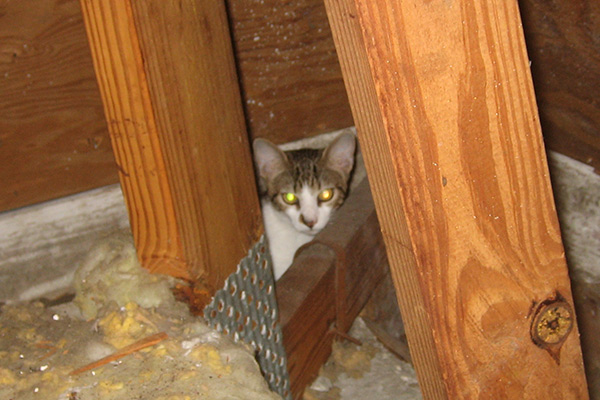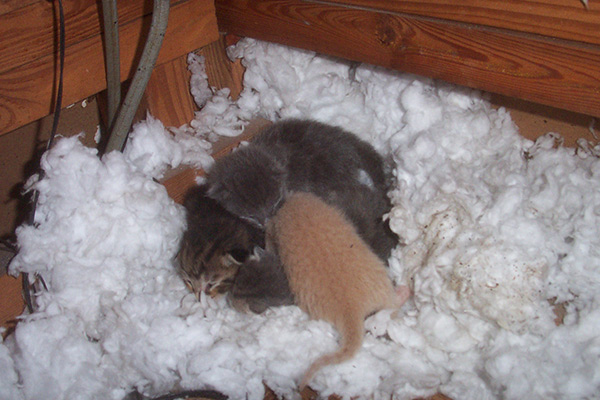- info@animalatticpest.com
- Call - we service 300 locations

How To Get Stray Cats Out of Your Attic
Yes, sometimes stray cats will inhabit the attic of a house. Stray cats, or feral cats as they are also called, behave like many other wild animals. On occasion, stray cats will find an attic a warm, dry, safe place
to live, much like a raccoon or squirrel does. In addition, feral cats often enter an attic for the same reason as wildlife - to have a safe space to give birth do, and raise, a litter of young. See the below photo of
a litter of kittens in the attic.
You remove feral cats in the attic much the same way as you remove a raccoon. First, you inspect inside the attic to confirm the species of animal. When you discover you have cats, you have to search the attic for any
litter of kittens. If you find one, remove the kittens and place them in a bucket or pillow case. Next, set a cage trap with the kittens in the back of the trap as "live bait" to catch the mother cat. Then you can bring
them all to a shelter together. Or, if there are no kittens, you have two options: First, you can set cage traps, baited with cat food, either on the roof (near the entry holes) or on the ground. But if you set traps on
the ground, be ready to catch non-target animals. Or second, you can set a one-way exclusion door (at least 5" size) at the entry/exit hole. This door lets the cats out, but not back in. Whatever you do, be sure not
to strand poor kittens in the attic to starve to death! Next, you'll want to find out how the cats got in the attic. They are large animals (compared to rats, for example), so the entry hole(s) should not be hard to find. Seal
the entry holes shut, only after you are sure all the animals are out of the atttic. Finally, you may want to clean the cat feces out of the attic. If you need professional help, we service most of the United States:
click here to hire us in your town.
How to Get Rid of Stray Cats in the Attic

Yes, cats do like to live inside attics
I have dealt with cats in the attic on many occasions. In this particular attic, I found a colony of five cats all living together. I was able to use an exclusion door to remove them all.

Be sure to carefully search for a litter of kittens in the attic!
One of the most common reasons a cat enters an attic is to have a safe place to give birth to and raise a litter of kittens. Be sure to find and remove the kittens before trapping the mother cat!
Information About Stray Cats in the Attic
How To Get Stray Cats Out Of Your Attic
Out of all the wild animals that may end up in your attic, stray cats are one of the most challenging to deal with. While domesticated cats can be friendly if not a bit skittish, stray or feral cats can sometimes be downright vicious, putting you at risk of scratches or bites if you handle them or get too close. While a cat in your attic is unlikely to bring you disease, there is always a risk that a feral one will spread rabies or another illness to your pets, which is why you should always ensure your own cats and dogs are vaccinated. Even without the risk of illness, stray cats can cause all sorts of damage to the attic, scratching on wood and other items or just leaving waste products.
For stray cats, attics make the perfect refuge. They are a nice and cozy, offering shelter from elements. At the same time cats are excellent climbers and jumpers, so it is no challenge for them to reach the attic, as long as they have a path inside. Because of this, you should know exactly what to do if you happen to have stray cats in your attic.
Check For Kittens
Anytime that there are stray cats in your attic, one of the first things you should do is check for kittens. In many cases, the cat will have young, which is why they searched out the attic in the first place. It can sometimes be hard to spot the kittens, but if you don’t see any right away, do a thorough search of the attic, preferably while the adult cat is out. You can also listen for sounds as kittens have very distinctive meows.
If there are kittens in the attic as well as the stray adult cats, you will need to take care of all the animals together. Separating the mother from the babies would mean certain death for the kittens and will lead the mother into a bout of depression in nearly every case. Sometimes, having kittens in the attic will actually make it easier to catch the mother as you can use her young as live bait, but this does pose its own challenge.
Pick Exclusion Or Live Trapping
There are two main methods of getting stray cats out of your attic. You can use an exclusion device or a live trap, both of which are options you will have with almost every other type of wild animal. Either method will work, but it comes down to personal preference. If there are young kittens in the attic, exclusion will not work since they won’t be able to leave by themselves.
Using Exclusion
If you choose to get the feral cats out of your attic via exclusion, the process is fairly simple. You need to start by figuring out how the cats are getting inside. If there are multiple entry points, seal all but one up so new cats can’t get inside once you remove the ones that are already there. Then, put an exclusion device or one way door over the remaining entrance. This way, the cats will be able to leave but not get back inside. After a few days, they should all be gone and you will be ready to seal the final entrance and clean the attic.
Using A Live Trap
The other option is to use a live cage trap to remove the cats and then bring them to your local animal rescue group. In most cases, you won’t have too much trouble catching the feline with a can of wet food, tuna, or a similar item. Always choose a large cage trap so the cat will fit since these animals can come in a range of sizes; traps designed for raccoons tend to be about the right size. If the cats in your attic include a mother and her kittens, you can wait until the mother leaves and grab the kittens by hand then place them in the trap. The mother will enter trying to free them and this way, you don’t have to worry about accidentally separating the cats.
What To Do With The Cat
The big controversy is what you should do with the stray cats that were in your attic. If they end up being domesticated cats that ran away and have a collar or microchip, then you will clearly want to return them to their owners. You can also release the cats after ensuring all entrances into your attic are sealed up tightly. If you do this, however, it is a very good idea to have them spayed and neutered first to help prevent future generations of stray or feral cats. You can also bring the cats to your local animal rescue association, animal services, or humane society.
Of course, you should also take some steps to keep stray cats out of your attic in the first place. These include never feeding stray cats and making sure that your attic is securely closed with no potential entry points for the felines.
The Bottom Line
How to get rid of stray cats in the attic - they are not so easily just "gotten rid of". But they can be properly and effectively removed, and the problem can be prevented from happening again. Remember to follow the steps above, whether you do it yourself or hire a professional to do it for you. It is not easy work, but if you don't remove the stray cats in your attic, they will go on to cause further damage. When you do decide to remove them, please remember to treat the animals with respect, and take the work seriously, and remember about the presence of baby stray cats in the attic. You can get rid of feral cats in the attic if you follow the correct approach. Best of luck!
